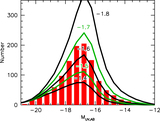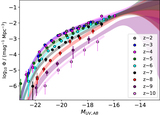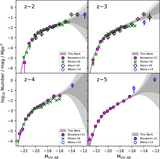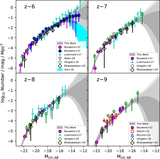Image Details

Caption: Figure 4.
The 68% and 95% likelihood contours (dark- and light-gray shaded regions, respectively) that we derive on the shape of the UV LFs at z ∼ 2, z ∼ 3, z ∼ 4, z ∼ 5, z ∼ 6, z ∼ 7, z ∼ 8, and z ∼ 9 based on our lensed HFF samples and the presented blank-field constraints on the LF. The presented contours give equal weight to the contours we derive treating the CATS, Sharon/Johnson, GLAFIC, and Keeton models as the truth in our forward-modeling procedure (Bouwens et al. 2017b) and then recover LF results using the median magnification factors from the other parametric lensing models. The red solid circles show the binned constraints (with 1σ error bars) that we obtain by dividing the number of sources in a luminosity bin N m by the selection volume V m in that bin (Table 4). The red upper limits are 1σ. The light-red shaded region (2σ) indicates the LF constraints if we adopt larger sizes in modeling the completeness of the faintest sources, as per the Shibuya et al. (2015) size–luminosity relations. At z ∼ 2–9, the blank-field constraints are from Bouwens et al. (2021a), but with comparisons to the results from Bouwens et al. (2007), Bouwens et al. (2015a), Bowler et al. (2015, 2017), Bouwens et al. (2019), Stefanon et al. (2019), and Bowler et al. (2020) also shown.
Copyright and Terms & Conditions
© 2022. The Author(s). Published by the American Astronomical Society.












